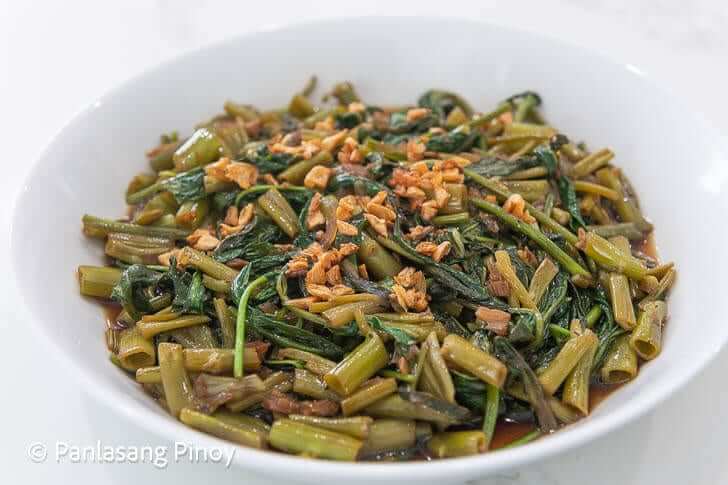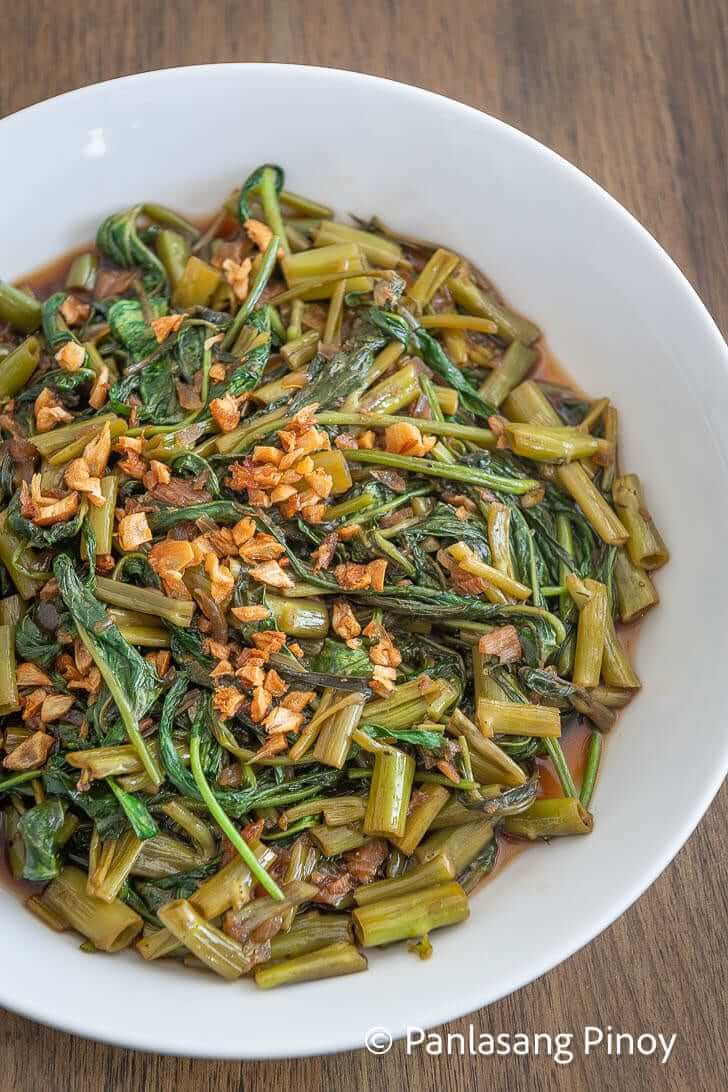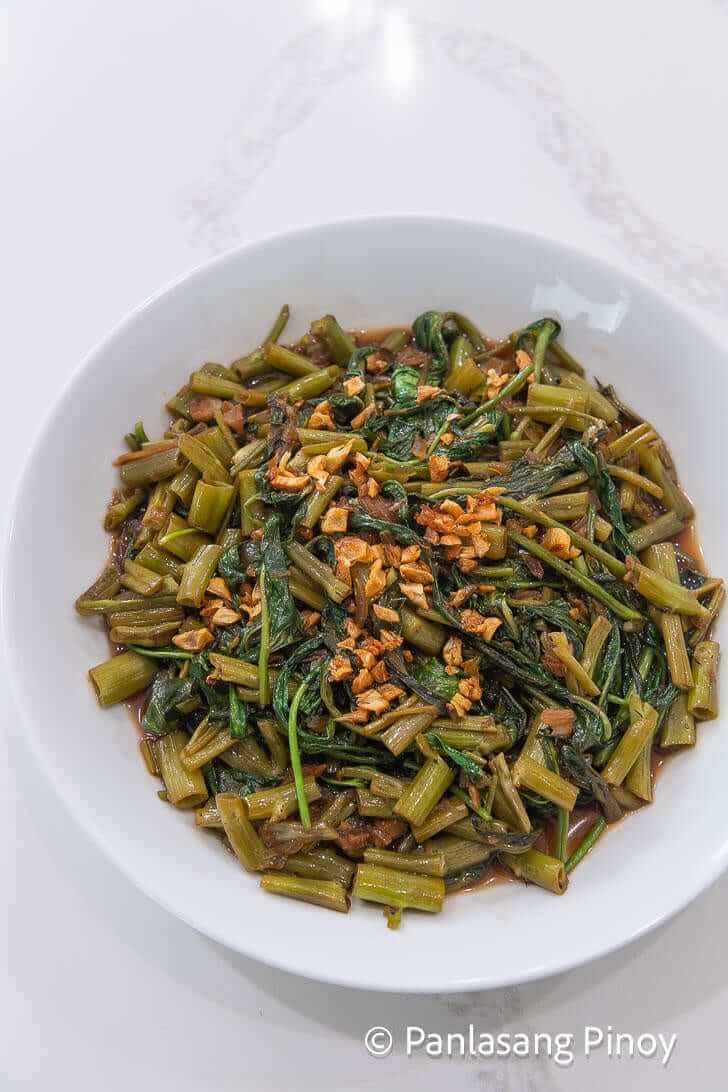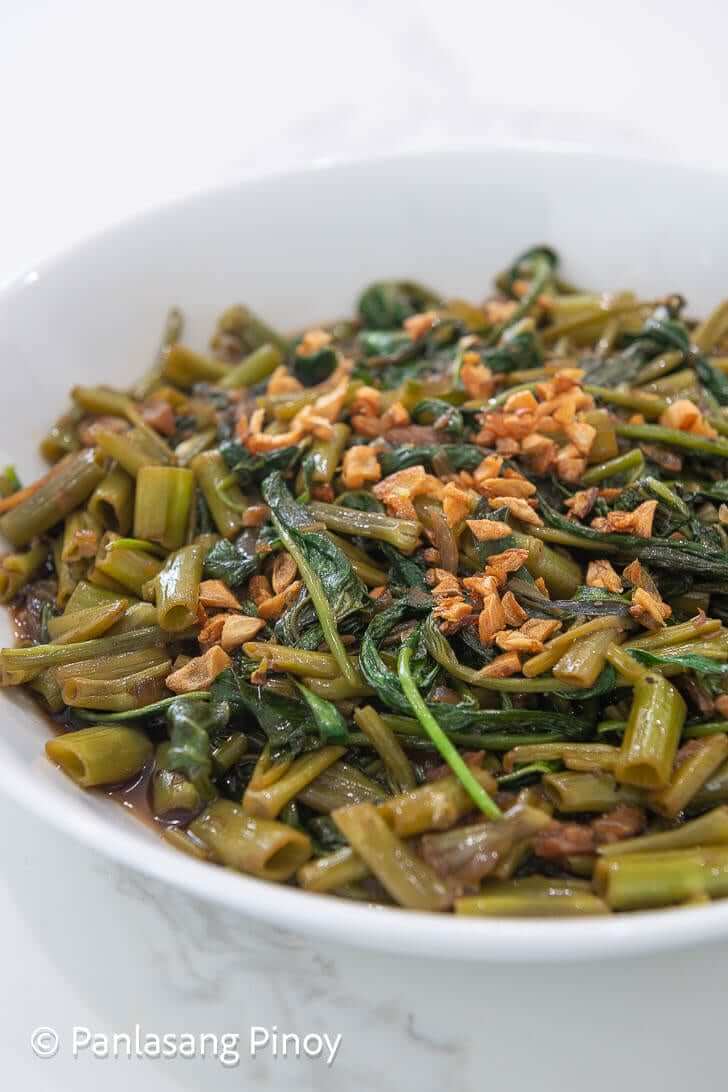Adobong Kangkong Recipe
Adobong kangkong is a classic dish you can find in several Filipino homes. This humble dish is a combination of several ingredients that are inexpensive and easily accessible. We already know how much Filipinos love adobo––but with kangkong especially, it’s so hard not to love!

All about kangkong
Kangkong is a kind of spinach––water spinach, to be exact. Similar to watercress, it is green, leafy, and mild in taste. Many of its dishes involve dousing it in strong tasting sauces, like soy sauce or oyster sauce, so it absorbs these tastes; it also brings out the slight nuttiness of its own flavors. Whether you’re boiling, blanching, or steaming it, kangkong is really versatile, and enjoyable no matter how you cook it.
But you don’t just eat kangkong because it’s delicious; you eat it because it’s nutritious, too! Kangkong is a great source of several nutrients, including but not limited to Vitamin A, copper, calcium, and zinc. All of the nutrients that comprise kangkong really make it a powerhouse of health––leaving your stomach happy and your body healthy!
For more fun facts about this great vegetable, you can check out this article all about kangkong here.
Adoring adobo

As we mentioned earlier, adobo is truly a classic. Rivaling only sinigang for the title of National Dish, I’m sure if you’ve been to a Filipino household you’ve had a variation of adobo at least once. Adobong kangkong is only one of the several ways you can make adobo. Here are some of my other favorites:
Of course, you can’t go wrong with the classic pork adobo. I love how succulent and juicy the pork belly in this recipe becomes, and paired with the adobo sauce? It’s nothing short of divine. This Coke Pork Adobo recipe is a great example of how you can put a twist on a classic comfort food. For this recipe, we’ve added Coke in order to tenderize the pork further, as well as add its own sweet flavor.
Chicken adobo is yet another traditional way of enjoying adobo. The great thing about adobo is how adaptable it is to several recipes; you can have it “wet” or “dry,” with more or less ingredients, and the result will almost always come out delicious. I really love this Killer Chicken Adobo because while it’s on the “dry” side, the sauce’s flavors really come out. We also use lemon lime soda in the marinade to add a more complex depth of flavors.
If you’re a seafood fan, then the Adobong Pusit might be the answer for you! True to its name, this Easy Adobong Pusit is easy to follow––and even easier to enjoy. I love how garlicky and umami the flavors of this adobong pusit get. And served over a heaping cup of warm rice, it’s simply unforgettable!

Adobong kangkong is the perfect dish for those who want that quintessential adobo taste, yet don’t want the heaviness of the usual protein. It also works for those who are short on time. Try this adobong kangkong today!
Let’s Cook Adobong Kangkong
The recipe for adobong kangkong is uncomplicated and quick. In just a few minutes’ time, you’ll already have a great appetizer or main course ready!
In a cooking pot, pour in 3 tablespoons of cooking oil. Let it heat up while you crush and chop a head of garlic, then toss it into the pot. Feel free to stir it around slightly until it begins to brown. Add your onion next. Make sure to cook it until the texture softens.
Pour in your soy sauce, vinegar, you can also add a quarter to half-a cup cup water if preferred. Bring it to a boil––this is already your adobo sauce. You’ll be adding in your kangkong next, but in two parts: the stalks, and then the leaves. Make sure to separate your kangkong leaves and chop the stalks to a length of about an inch.
Add your kangkong stalks and let your adobong kangkong cook for about a minute or two. Then, sprinkle salt and ground black pepper to taste, stirring the kangkong stalks in the adobo sauce gradually.
Afterwards is the time to add in your kangkong leaves to your adobong kangkong, and stir it gently. Cook these for about 30 seconds, as kangkong leaves cook very quickly; we don’t want them to become too tough, nor too bitter.

Transfer your adobong kangkong to a serving plate and top it with roasted garlic. You can enjoy adobong kangkong with a meat dish of your choice, if you prefer. However, serving it with rice is enough to take in its explosive flavors. The rice will soak up the adobo sauce with ease, and it’s bound to be a favorite. Share it and enjoy!
There is another version of this dish that originated in the Visayas region which I would love you to try. It is called apan-apan.
Have fun cooking this adobong kangkong! Let us know what you think!
Adobong Kangkong Recipe
This is a recipe for adobong kangkong. It is a Filipino vegetable dish wherein the water spinach is cooked inadobo style.
Ingredients
- 1 bunch kangkong leaves and stalks separated. Stalks cut in 1-inch pieces
- 1 piece onion chopped
- 1 head garlic crushed and chopped
- 1/4 cup soy sauce
- 1/8 cup vinegar
- 1/2 cup water optional
- 3 tablespoons cooking oil
- Ground black pepper
Instructions
-
Heat oil in a pan.
-
Add the garlic. Saute until the color turns golden brown. Scoop-out a quarter of the browned garlic and put in a clean bowl. Save this later for garnish.
-
Add chopped onion. Saute until it softens.
-
Pour the soy sauce and vinegar in the pan. Let the liquid boil.
-
Add the Kangkong stalks. Cook for 2 minutes.
-
Add the Kangkong leaves. Stir. Continue cooking for 30 to 1 minute. Cover the pan and cook for 1 minute.
-
Season with ground black pepper. Note: you may also add salt if needed.
-
Transfer to a serving bowl and then top with browned garlic.
-
Serve. Share and enjoy!
Nutrition
Serving: 4g | Calories: 169kcal | Carbohydrates: 8g | Protein: 4g | Fat: 14g | Saturated Fat: 1g | Trans Fat: 1g | Sodium: 1106mg | Potassium: 190mg | Fiber: 1g | Sugar: 2g | Vitamin A: 1178IU | Vitamin C: 16mg | Calcium: 45mg | Iron: 1mg
Watch How to Cook Adobong Kangkong
[embedded content]
